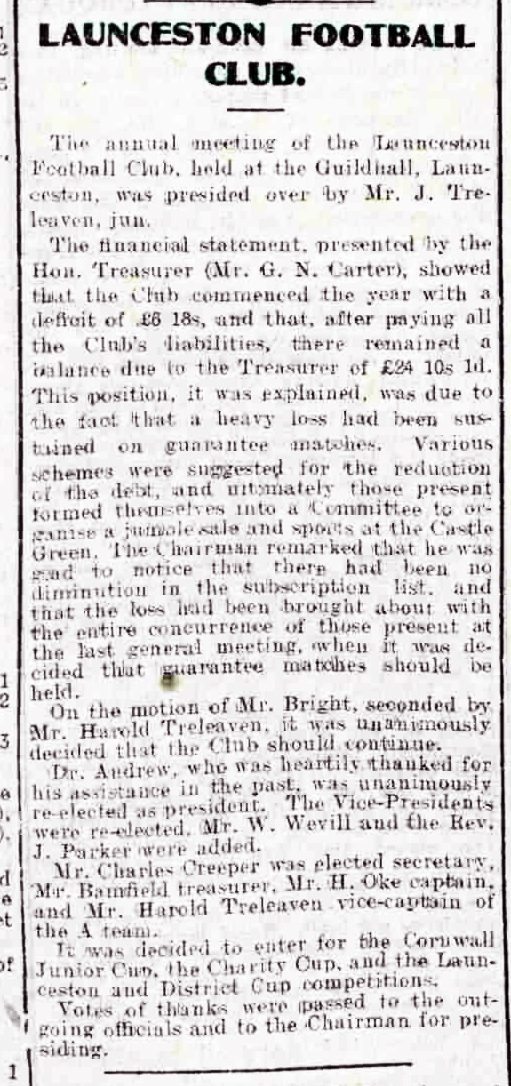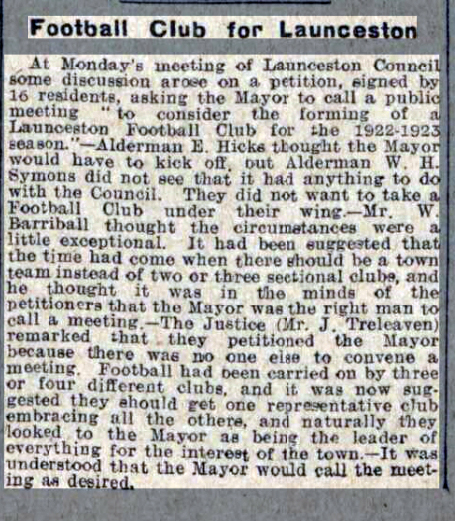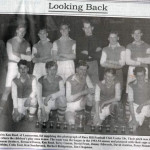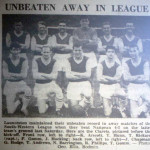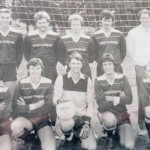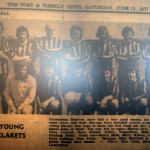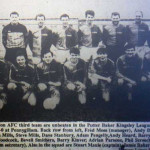.
The first mention of any footballing side representing the town was in September, 1869, when a Launceston side faced the Rifle Corps over two games. In the second match played at Pennygillam, the Rifle Corps ran out 4-0 victors (match report below).

Although it is very probable that football continued to be played, but it wasn’t until December 1876 that any match was reported, this one between Launceston Grammar School and Tavistock Grammar School. The match was played at the Horwell Endowed School’s playing field and Launceston ran out winners, winning 2-1 with goals from Roberts and Gamble.
The following year in November 1877, a team facing Tavistock were described by a Tavistock paper as ‘specimens of Cornish giants.’ ‘The Cornish and Devon Post’ reported on the match thus: “Launceston v. Mr. Watkins’ eleven (Tavistock): A match was played between the above teams on Wednesday last on the ground of the Grammar School at Tavistock, and resulted in a victory for the former by one goal. This is the first match that has been played by the Launceston Club, and the manner in which the Eleven sustained the contest, after the small amount of practice they have yet had, encourages the hop that Launceston will soon be represented in the Foot-ball (note the hyphen then used) world by a moderately strong team. The rules observed were ‘Association’ and great good humour and friendliness prevailed throughout the game. It is but fair to add that although the Tavistock men had the advantage in training, the balance of weight lay on the side of the victorious eleven.” It was announced shortly after this match that Launceston would play Liskeard, but this was postponed.
Another mention is made of a match between the town and Dunheved College two years later where they ran out 3-1 victors (report below).
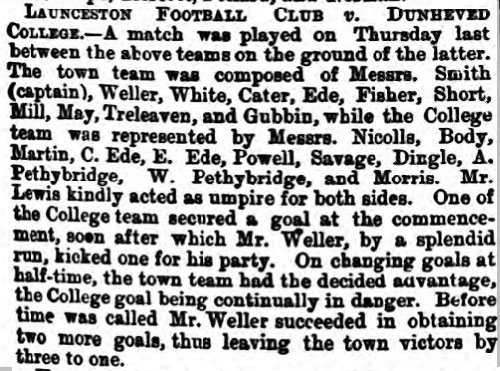
This however, were just fleeting occasions whereby sides representing the town were put together with a distinct lack of enthusiasm in organising an official footballing side. Another match between a Launceston side and Dunheved College took place on Thursday, December 15th, 1887. This ended in a goalless draw: “a goal was claimed by either side, but neither was allowed,” wrote the following report. Launceston could only filed a team of ten as many that were selected failed to turn up. The Launceston team that day were: C. Wise, A. Peake, E. White, H. Short, C. Hayman, H. Riley, Mills, J. K. White, W. Cater. The Dunheved College team were: J. Powell, G. Idle, J. Treleaven, J. Pethybridge, A. Thomas, F. Wiseman, W. Gubbin, J. McLachlan, A. Nicolls, W. Fisher, G. Nicolls.
A club was formed in 1888 but due to poor results for that year, were allowed disband by the following year. This didn’t prevent matches being played within the borough like the match between the Temperance Brigade boys and Horwell Endowed School in March 1889 with the former winning 1 nil. The Temperance Brigade continued to operate a football team taking on matches against other local sides on an ad-hoc basis.
With a continued interest in forming a club, a meeting was held on September 2nd 1891 in the Guildhall. After some discussion , as to whether it should be a Rugby or an Association Club, it carried by a vote for Association. The officers were then elected as follows:- President, Mr. W. Wevill; vice-presidents, Messsrs Hawkens, Downing, Body, and Hare; secretaries Messrs Wenn and Knill; Treasurer Mr. G. Nicolls; committee, Messrs Cocks, F. Pethybridge, Matthews, Hockin and Prout. A half-crown subscription was decided upon. And so the Clarets were born with their ground being on part of what was then Pennygillam Farm, and today the location of St. Johns Road.


As there was no organised league in place, over the next few years the club continued to play arranged matches with no set format. However, the inaugural Cornwall County Football Association Senior cup competition started in 1892 and Launceston made it to the final, losing to Penzance 5 nil. In fact Launceston went on to appear in six of the first ten finals but it wasn’t until the 1899-1900 season that they broke their duck ending a run of final defeats to Penzance by beating the ‘Magpie’s’ 3 nil. The following season they again met Penzance in the final this time thrashing them 5-1! This would be the end of their run, and it would be another 82 years before the ‘Clarets’ would grace a Senior cup final again when they defeated Falmouth 1 nil in the 1983 final.





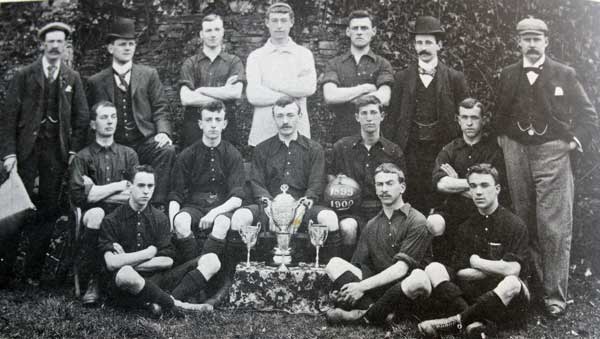




From possessing a side that had dominated at the turn of the century, Launceston began to struggle on the playing field and by 1906 there was a lack of drive to take the club forward. This culminated in April when due to a poor playing surface after bad weather, Launceston wired through to Wadebridge to cancel the scheduled Cornwall Charity match. Wadebridge still attended but by that time Launceston could not get a team together. At a following Cornwall County F.A. meeting it was decided to award the match to Wadebridge and an order was given for Launceston to pay the out of pocket expenses for the Wadebridge team. The Hon. secretary, Mr. W. T. Mills wrote to the C.C.F.A. stating the unfairness of the award with the result that the C.C.F.A. agreed to meet half the expenses themselves. After a further infringement by Launceston the C.C.F.A. suspended any football to be played at the Pennygillam ground from April 23rd and October 31st 1906. Feeling aggrieved at this decision and with the lack of desire from the players, the committee decided to wind the club up at a meeting held on August 24th 1906.

However, this wasn’t the end of football to be played at Pennygillam in 1906, for a team representing the Boys of England took up the opportunity once the ban was over, to organise a series of friendly matches there. This pattern continued until the end of the 1907-08 season. By the beginning of the following season the B.O.E. had brought renewed interest for the game and at their annual meeting (report below left) held on August 17th 1908, it was decided to rename the club ‘Launceston Football Club.’ At the same time it had been suggested to where the same claret strip of the old club, but due to costs it was agreed to just the name change. At the same time it was agreed to put the club forward to play in the junior cup and the Charity cup. A list of fixtures were soon organised with the the first match, a trial, played on September 17th between Possibles and Probables. This was followed up with home matches against the Rifle Brigade, Royal G.A. (match report below right), the Royal Marines and Tavistock and an away match against Liskeard.

Even with the renewed enthusiasm, putting together a side continued to be a problem and the Cornwall junior cup tie at Camelford had to be postponed in January 1909 at the last minute with the club having to reimburse Camelford for their expenses. These problems aside, the Clarets reached the final of the competition at Bodmin where they were defeated 5-2 by St. Blazey (match report below left).


It was in 1909 that another club was formed, Launceston Athletic Football Club, and a ground was laid out at Chapple. The president of the new club was Mr. W. S. Cater and secretary Mr. E. J. Sharland.The club colours were black and white stripes with white shorts. The club was formed for the young men who wanted to play a game and who were unlikely to feature for the Launceston Football Club. In effect the club acted as a reserve team with many going on to feature for their local rivals and by 1912 ‘Athletic’ had been absorbed by the clarets.


The First World War brought to an end any football which didn’t return to the town until 1919 when a new club was formed our of ex soldiers calling themselves Launceston Comrades Football Club.


The ‘Comrades’ found success on their second season when the beat St. Dennis 4-0 in the Eastern Division of the Cornwall Junior Cup.

Although successful in the Junior Cup it was felt in the town that the Comrades along with three other town sides should come together to reform the Clarets. With this in mind Mayor James Treleaven convened a meeting to discuss the idea in June 1922.
And so on June 22nd at the convened meeting it was agreed to combine all the football teams into one and the Clarets reformed. James Treleaven was elected as president with Messrs J. Slocombe and C. N. Glanfield being elected hon. secretaries and Mr. W. Libby the treasurer. The following year Mr. William Barriball, the mayor, was elected as president and the club entered the Cornwall Senior Cup, Cornwall Charity Cup, and the Devon and Cornwall League. The club subsequently joined the Plymouth and District League but in 1926 had to tender their resignation due to being unable to compete on Saturday’s due to it being the town’s market day and many of the players having to work. It was noted that there was always a strong team available on Thursday’s, Launceston’s half day closing. The club rejoined the league in the second division two years later and were successful in winning the Division cup whilst also finishing third for the Cornwall Senior Cup.


In 1930 the club were deducted five Senior Cup points for fielding an ineligible player, C.C. Dawe, in a Cup game. It was also in this year that an official Launceston Football Club Supporters Club was founded with Mr. F. L. Houghton as chairman, and Mr. E. G. Courtney as treasurer. This club went on to hold annual boxing matches in the town hall over the subsequent years. In 1932 the club announced that after a lapse of several years, they would compete in junior football the following season.

The problem of Launceston’s half day closing came to the fore again at the 1933 AGM, where it was stated by a Mr. Willmott ‘that they would never get good support Launceston changed its early closing day.’ A £60 deficit was again carried over and the club was losing £2 on every match played.
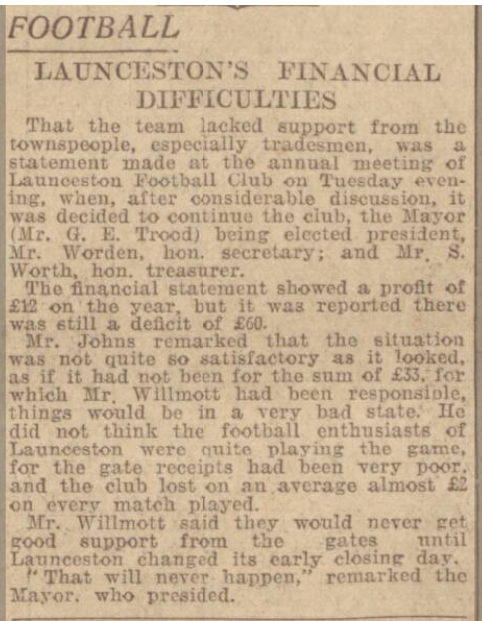

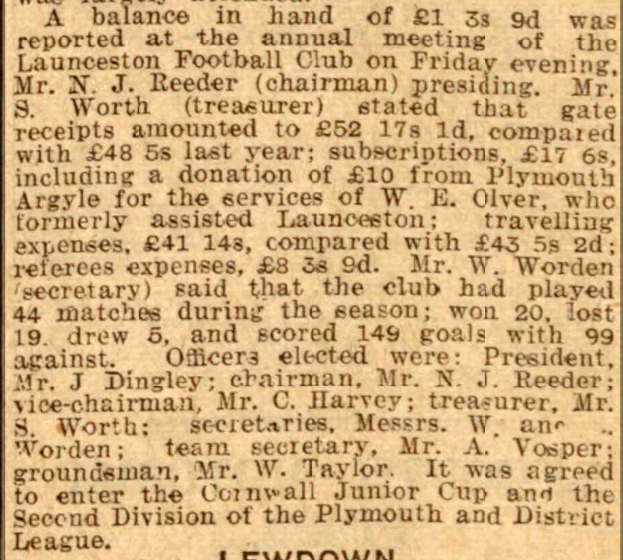
Again war brought to an abrupt end any football in the town, but the club committee were soon planning for the future after holding their first post war AGM (below left) in November 1945. Here it was agreed to play a series of friendly matches for the balance of the season. It wasn’t until October 1946 that the Clarets began playing competitively with a ‘B’ team playing in the Launceston and District League (Below Right). It took until 1948 before the club could put out a ‘senior’ side rejoining the Plymouth and District League.


Launceston joined the South Western League in 1958, before leaving in 1961 and then rejoining again for another four-season spell in 1966, and again in 1978 – this time they retained membership until 2007 when they joined the newly formed South West Peninsula League in its Premier Division. They had won the South Western League once, in the 1994–95 season.
The club were admitted to the FA Vase in 2002, with their best performance to date coming in the 2006–07 season, where they reached the second round. In 2008–09 participated in the FA Cup for the first time, progressing through the Extra Preliminary Round before losing in the Preliminary Round.
Launceston Football Club Honours
Cornwall Senior Cup
Winners: 1899-00, 1900-01, 1982-83, 2004-05.
Runners Up: 1892-93, 1894-95, 1897-98, 1898-99, 1992-93.
Cornwall Junior Cup
Runners Up: 1900-01, 1908-09
Plymouth and District League 2nd Division Cup
Winners: 1929
Plymouth and District League Senior Cup
Winners: 1953-54
Plymouth and District League Coronation Cup
Runners Up: 1953-54
South Western League
Winners: 1994-95.
Runners Up: 1983-84.
South Western League Cup
Winners: 1995-96, 2006-07.
Cornwall Charity Cup
Runners Up: 2007-08.
Football Gallery.

Visits: 125



